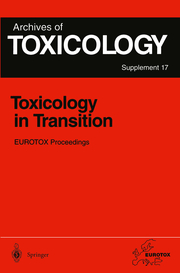Detailansicht
Toxicology in Transition
Proceedings of the 1994 EUROTOX Congress Meeting Held in Basel, Switzerland, August 21-24,1994, Archives of Toxicology 17
ISBN/EAN: 9783642794537
Umbreit-Nr.: 4379222
Sprache:
Englisch
Umfang: ix, 569 S.
Format in cm:
Einband:
kartoniertes Buch
Erschienen am 30.12.2011
Auflage: 1/1995
- Zusatztext
- InhaltsangabeGenetically Modified Cells and Animals in Toxicological Research.- Concepts, potentials, methods for constructing transgenic cells and animals - Introduction.- Use of recombinant cells in metabolic and mechanistic studies (analysis of pathways).- Applications for transgenic animals in toxicology.- The Benchmark Dose Concept.- Principles, benefits and limitations of the NOEL approach.- Comparison of benchmark doses (BMD) with no-observed-adverse-effect-levels (NOAEL) and low-observed-adverse-effect-levels (LOAEL) for subchronic studies.- Bfoindicators in Ecotoxicology.- Bioindicators in ecotoxicology: an overview.- Use of cytochrome P450 1A in fish as a biomarker of aquatic pollution.- Receptor-mediated toxicity.- Cellular and molecular biology of aryl hydrocarbon (Ah) receptor-mediated gene expression.- Inhibitors of the sodium pump: toxins, then drugs, and now hormones.- Rodent responses to peroxisome proliferators - a receptor-mediated phenomenon ?.- Role of second messengers in mineral particle-induced production of reactive oxygens species by phagocytes.- Estrogenic effects of some xenobiotics.- In Vitro tests in regulatory toxicology.- In Vitro methods in regulatory toxicology: the crucial significance of validation.- Scientific, ethical and legal aspects of the acceptance of in vitro methods in regulatory toxicology.- The validation and use of in vitro teratogenicity tests.- In Vitro methods in regulatory toxicology.- In Vitro tests in regulatory toxicology: symposium chairman's summing-up.- Ex Vivo and in Vitro Models in acetaminophen hepatotoxicity studies. Relationship between glutathione depletion, oxidative stress and disturbances in calcium homeostasis and energy metabolism.- Rabbit renal proximal tubule suspensions as a model for nephrotoxicity evaluation of native or in situ metabolized B-lactam antibiotics.- Neurobehavioral abnormalities induced by substance abuse.- Neurobehavioral abnormalities induced by prenatal exposure to substances of abuse - stating the problem.- Prenatal exposure to marihuana and tobacco during infancy, early and middle childhood: effects and an attempt at synthesis.- Delayed developmental neuro-and immunotoxicity of benzodiazepines.- Changes of EEG of freely-moving rats caused by three generation organophosphate treatment.- Developmental neurotoxicity of carbon monoxide.- Safety assessment of over the counter (OTC) products.- The safety assessment of over the counter (OTC) products.- OTC pharmaceuticals and genotoxicity testing: the paracetamol, anthraquinone, and griseofulvin cases.- Safety assessment of OTC products: doxylamine succinate.- Safety assessment of OTC products: a regulatory view.- Drug toxicity findings and no action taken.- Species specificity of organ toxicity.- Species specificity of organ toxicity.- Species specificity at the molecular level: the case of nitric oxide synthase.- Mechanisms underlying species-specificity in target organ specificity.- Species specificity of organ toxicity: behavioral differences.- Terrestrial ecotoxicity of chemical substances.- Development of OECD test guidelines and hazard assessment procedures for terrestrial effects.- Development of guidance for terrestrial effects assessment.- Application of quick and simple plant bioassays to assess the genotoxicity of environmental pollutants - Detection of potential health hazards of air, water and soil contaminants.- Comparison of susceptibility to chemicals (pesticides) of species used for human and environmental effect assessment.- Toxicological evaluation of pollutants in soil - concept of the AGU and assessment of tolerable concentrations for metals.- Immunodeflcient mouse systems.- The SCID (severe combined immnodeficiency) mouse - its biology and use in immunotoxicological research.- The SCID mouse as a tool to bridge the gap between animal and human responses.- The SCID mouse and its use in immunopharmacological and immunotoxicological investigations.- Stereochemical effects.- Chirality -
